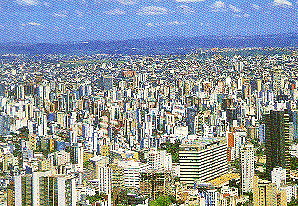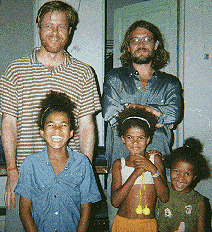
Robert Willey

I was a Fulbright Scholar at the Universidade Federal de Minas Gerais (UFMG) from August to December of 1996. My purpose was to teach computer music courses, assist in the development of facilities for music technology within the Escola de Música, and participate in the organization of the fourth symposium held by NUCOM.
Before starting teaching in Belo Horizonte I attended the third symposium by NUCOM held in Recife. I presented a lecture/concert with Jônathas Manzolli on computer-controlled piano music, some of which came from pieces in the archive of pieces I've collected in San Diego. At a meeting to discuss business I was electedto coordinate the tutorials for the fourth symposium, to beheld August 4-8 in Brasília.

I taught two courses, one called "The Virtual Studio" for
performers, and a survey of computer music more oriented towards
composers, though there was quite a mix of backgrounds in both
courses and some overlap. In this picture above we see some of the
performers. The horn player seated in front on the right did a piece
for tape (generated with software synthesis using csound) and
trombone. We worked quite a bit with Max (programming environment for
interactive MIDI) and Vision (sequencing). Part of Fulbright's grant
includes the purchase of textbooks and
teaching materials that are then left at the host institution.
I started an outline for a text on computer music in Portuguese, and invited other NUCOM members to contibute to an online document. Rodolfo Caesar at UFRJ has combined these materials with his site, the largest academic music technology resource in Brazil. Gilberto Carvalho, one of the music school's professors, contributed two translationsof articles he made of papers of Richard Moore. Gilberto made a presentation to the composition class about csound and the composing programs he has written that generate score files.
 The classes were taught in a
classroom that was setup for new equipment that had recently been
purchased, including an 8-bus Mackie mixer, Roland keyboard, Opcode
Studio 3 MIDI interface, 2 Power PC Macintoshes, DAT, ADAT, compressor,
Quadreverb, amp, and monitor speakers.
The classes were taught in a
classroom that was setup for new equipment that had recently been
purchased, including an 8-bus Mackie mixer, Roland keyboard, Opcode
Studio 3 MIDI interface, 2 Power PC Macintoshes, DAT, ADAT, compressor,
Quadreverb, amp, and monitor speakers.
I taught the class for
composers how to make web pages, and continued on my project called
El Camino de Silicio
("TheSilicon Highway"),
with information on
Brazil
.
![]()
The Escola de
Música continued in its historic building in the center of town.
During my stay their new facility was being completed at the main
university campus on the outskirts of town. I helped with plans for the
network and studio organization, and contributed to grant proposals to
equip the new labs.
Together with Sergio Freire (another professor at the school)
we wrote a proposal for a national competition
to fund advanced laboratories. Our proposal was one of the ones
selected from over a thousand submitted, and the school will be
receiving $150,000 to outfit the
studios in the new building which they moved into the semester
after I left.
Inside the building there are three rooms for theory
(with a dozen Pentiums), a composition studio, and a performance
studio. At the last minute an extension was made to the back of the
auditorium to provide more space for technology, and to incorporate
it into the auditorium, where they have network lines going to the
stage and where the mixer will go during concerts. In this picture we
see the back of the building with the rear of the auditorium exposed,
where the last two labs are being built. The one in the middle with
the ramp leading up to it looks
into the auditorium and will be used as a recording studio. The one above
is for operating lights, the one below may be used for commercial music,
pop music, sound tracks, rehearsal and recording.


Maurício Loureiro was the coordinator of my
visit at the school. He has been a tireless champion of
moving into the twentieth century at the school and helped
me with so many things throughout the five months, one of the great
experiences I had in Belo Horizonte was getting to know his family.
Together with Sergio Freire (another professor at the school)
we wrote a proposal for a national competition
to fund advanced laboratories. Our proposal was one of the ones
selected from over a thousand submitted, and the school will be
receiving $150,000 to outfit the
studios in the new building which they moved into the semester
after I left.
Maur&iacoute;cio and I have worked together in the
past with the NUCOM planning, during his stay in
San Diego at CRCA, and when I visited UFMG the first time
at which time I
worked with the new music ensemble there. On October
29th we played at the ninth Brazilian symposium on
computer graphics and image processing, held at the
Hotel Glória in Caxambu, across the street
from the park of waters, reputed to have one of the
largest varieties of mineral waters in the world.
We performed a collaboration entitled "Caxambulismo"
for clarinet, Buchla Lightning, and electronics.
I had created a Max patch to map Maurício's
movements, with one wand attached to the end of the
clarinet, and the other attached to his leg. In
the picture we see me, the sound company's engineer,
and Sergio Freire,
who is an expert audio engineer
among other things. Sergio was in a horrendous car
accident towards the end of my stay and was
lucky to survive.

I gave workshops in Londrina and Brasília. While
in Brasília I met with Aluízio Arcela and Conrado
Silva (almost discernable in this photo below) to discuss plans for
the symposium next year, and
agreed to assist invited guests from abroad.
![]()
 Before returning to California at the end of December
I made a trip to some of the wonderful destinations in
Brazil, passing Christmas in Salvador, Bahia. I looked
up a friend I had made two years before when I gave a
workshop at the Winter Festival in Ouro Preto. Fred
Dantas is a bandleader and trombonist. He invited me
to a concert he directed Christmas eve in a square in
the Pelourinho district. Two days later he invited
me to hear another group rehearse at his house, on
the way up the stairs several neighbor kids attached
themselves to us and swept the courtyard for a dollar.
Fred told them I was his brother. One of them was playing
with the "clacker" toy, which I saw quite a number of
during in the Christmas shopping areas on the street,
a toy that was banned years ago in the States because
of its danger to the eyes. The biggest of the girls
swept the porch while we talked and the three told us
at least twenty things they could do with the dollar
they expected from Fred for getting rid of the leaves.
Before returning to California at the end of December
I made a trip to some of the wonderful destinations in
Brazil, passing Christmas in Salvador, Bahia. I looked
up a friend I had made two years before when I gave a
workshop at the Winter Festival in Ouro Preto. Fred
Dantas is a bandleader and trombonist. He invited me
to a concert he directed Christmas eve in a square in
the Pelourinho district. Two days later he invited
me to hear another group rehearse at his house, on
the way up the stairs several neighbor kids attached
themselves to us and swept the courtyard for a dollar.
Fred told them I was his brother. One of them was playing
with the "clacker" toy, which I saw quite a number of
during in the Christmas shopping areas on the street,
a toy that was banned years ago in the States because
of its danger to the eyes. The biggest of the girls
swept the porch while we talked and the three told us
at least twenty things they could do with the dollar
they expected from Fred for getting rid of the leaves.